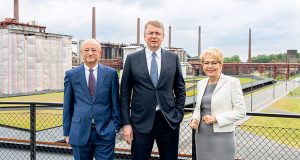The German government has set itself the goal of rapidly expanding its renewable energies as part of the energy transition. Sun and wind, however, are subject to fluctuations in relation to the weather, and are not geared towards demand and market requirements. To offset these fluctuations and guarantee that the power supply can meet demands, high-performance energy-storage systems will be needed in the future. Pioneers of battery storage technology are entering the “Innovative Solid Battery” project outline in the “Living Labs for the Energy Transition” ideas competition staged by the German Federal Ministry for Economic Affairs and Energy (BMWi) and want to replace conventional lithium-ion batteries with new technology.
High Performance Battery Technology GmbH, headquartered in Bonn, the Essen-based company STEAG GmbH, the Institute for Technology Assessment and Systems Analysis (ITAS) of the Karlsruhe Institute of Technology (KIT) and five further partners from the fields of science and industry have joined forces and submitted a corresponding project outline to the Federal Ministry for Economic Affairs. The federal government wants the “Living Labs for the Energy Transition” competition to promote energy storage in the electricity sector. The storage is to be tested in a real-world environment and enable integration of renewable energy into the energy system.
As an operator of six large-scale battery systems, STEAG is already leading the way. The energy company has been developing vital expertise since 2016 as one of Europe’s largest storage operators. STEAG’s storage batteries are already being used to offset frequency fluctuations in the grid, caused by the increased supply of volatile renewable energies. Within seconds, the large-scale storage batteries can extract excess energy from the grid, or feed the required energy into it.
The objective of the “Innovative Solid Battery” project is to develop and test a new battery technology to replace the conventional lithium-ion battery. “The high-tech batteries boast an extremely impressive and unique combination of performance data,” says Günther Hambitzer, CEO and chair of the board of High Performance Battery Holding AG, based in Switzerland. They are non-flammable, deep-discharge-proof, long-lasting, and there is no raw material shortage. They also have an almost constant capacity with almost constant internal resistance, considerably better for the environment than conventional lithium-ion batteries (50 % less CO2 equivalent over their life cycle).
The project findings will be used in a wide range of applications:
- network stability and flexibility options;
- stationary network buffering for electromobility as an infrastructure to support charging stations;
- home storage;
- applications for an uninterruptible power supply; and
- power tools and consumer electronics.
“The battery size can range from container storage with a capacity of several megawatt hours down to small batteries of fractions of a kilowatt hour,” concludes Hambitzer. (STEAG/Si.)


